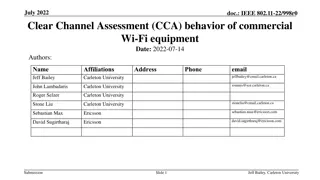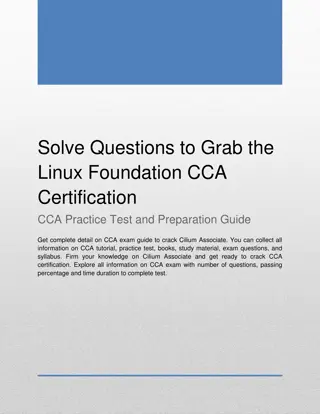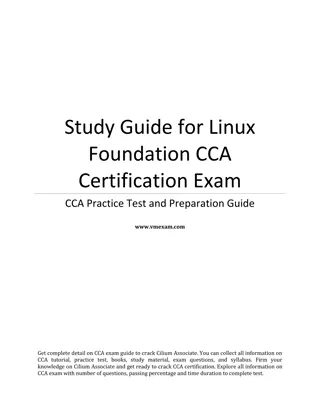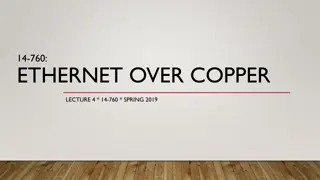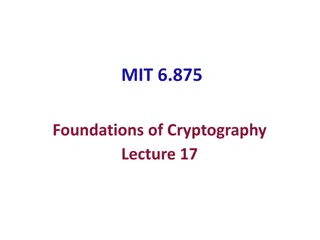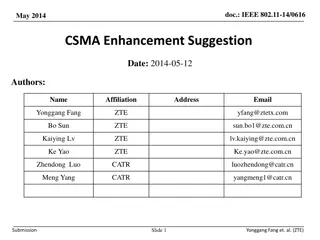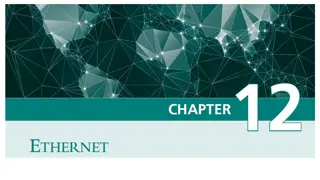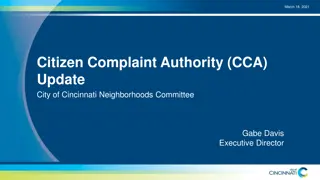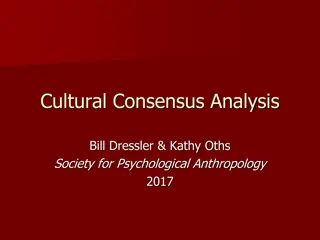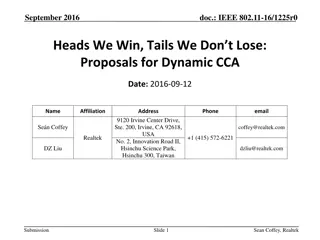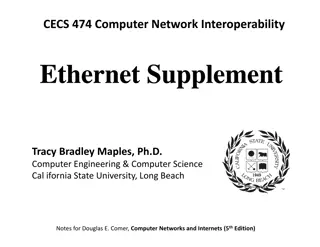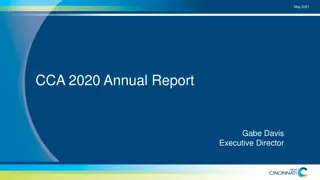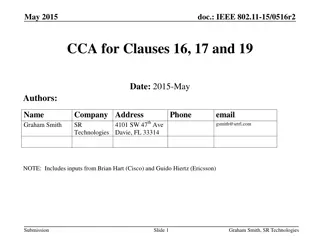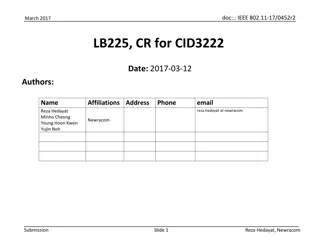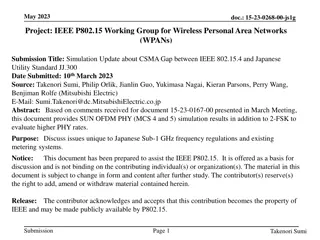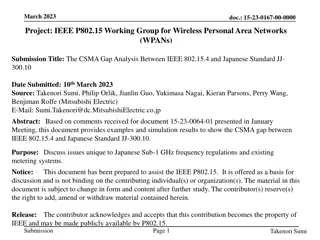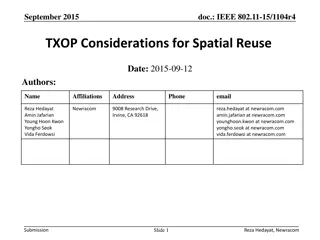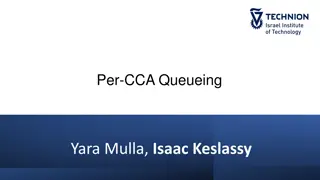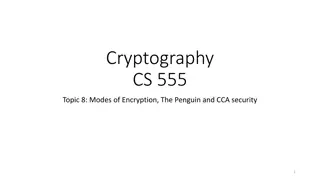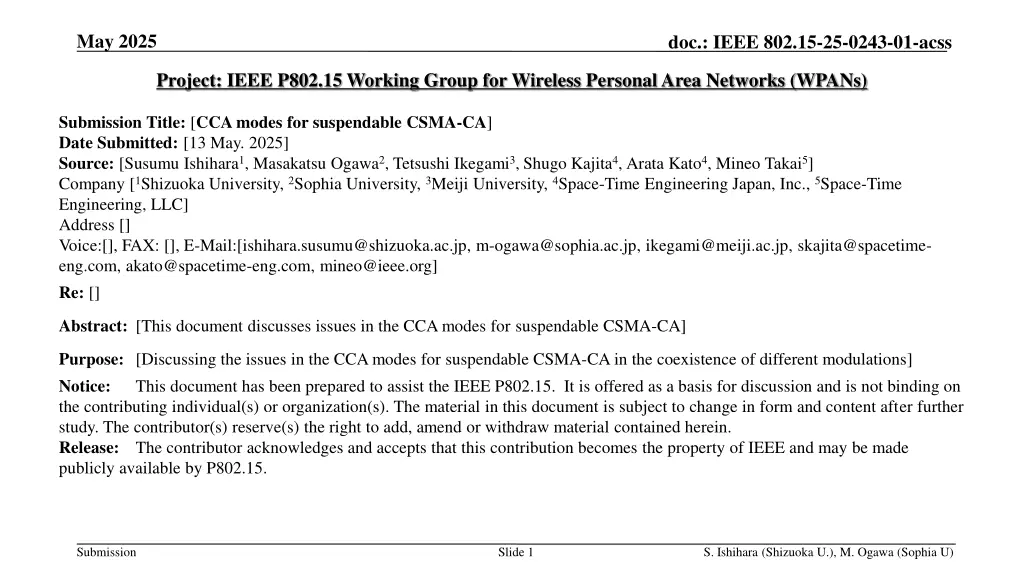
Understanding CCA Modes for Suspendable CSMA-CA in WPANs
Explore the dynamics of Carrier Sense Multiple Access with Collision Avoidance (CSMA-CA) in Wireless Personal Area Networks (WPANs), focusing on the different Clear Channel Assessment (CCA) modes and their impact on coexistence with various modulations. Delve into the significance of suspendable CSMA-CA and the challenges associated with determining dynamic ED thresholds for efficient channel utilization.
Uploaded on | 1 Views
Download Presentation

Please find below an Image/Link to download the presentation.
The content on the website is provided AS IS for your information and personal use only. It may not be sold, licensed, or shared on other websites without obtaining consent from the author. If you encounter any issues during the download, it is possible that the publisher has removed the file from their server.
You are allowed to download the files provided on this website for personal or commercial use, subject to the condition that they are used lawfully. All files are the property of their respective owners.
The content on the website is provided AS IS for your information and personal use only. It may not be sold, licensed, or shared on other websites without obtaining consent from the author.
E N D
Presentation Transcript
May 2025 doc.: IEEE 802.15-25-0243-01-acss Project: IEEE P802.15 Working Group for Wireless Personal Area Networks (WPANs) Submission Title: [CCA modes for suspendable CSMA-CA] Date Submitted: [13 May. 2025] Source: [Susumu Ishihara1, Masakatsu Ogawa2, Tetsushi Ikegami3,Shugo Kajita4, Arata Kato4, Mineo Takai5] Company [1Shizuoka University, 2Sophia University, 3Meiji University, 4Space-Time Engineering Japan, Inc., 5Space-Time Engineering, LLC] Address [] Voice:[], FAX: [], E-Mail:[ishihara.susumu@shizuoka.ac.jp, m-ogawa@sophia.ac.jp, ikegami@meiji.ac.jp, skajita@spacetime- eng.com, akato@spacetime-eng.com, mineo@ieee.org] Re: [] Abstract: [This document discusses issues in the CCA modes for suspendable CSMA-CA] Purpose: [Discussing the issues in the CCA modes for suspendable CSMA-CA in the coexistence of different modulations] Notice: This document has been prepared to assist the IEEE P802.15. It is offered as a basis for discussion and is not binding on the contributing individual(s) or organization(s). The material in this document is subject to change in form and content after further study. The contributor(s) reserve(s) the right to add, amend or withdraw material contained herein. Release: The contributor acknowledges and accepts that this contribution becomes the property of IEEE and may be made publicly available by P802.15. Submission Slide 1 S. Ishihara (Shizuoka U.), M. Ogawa (Sophia U)
May 2025 doc.: IEEE 802.15-25-0243-01-acss Topics in this presentation CCA modes for suspendable CSMA-CA Mode 1: Carrier sense only (CS) Mode 2: Energy above threshold (ED) Mode 3: {3a: CS and ED, 3b: CS or ED} Dynamic ED threshold for co-existence How to determine the threshold? Submission Slide 2 S. Ishihara (Shizuoka U.), M. Ogawa (Sophia U)
May 2025 doc.: IEEE 802.15-25-0243-01-acss IEEE 802.15.4 CSMA-CA IEEE 802.15.4 CSMA-CA performs CCA (Clear Channel Assessment) only when the backoff timer expires, and does not perform carrier sense in order to minimize power consumption during backoff. (IEEE 802.11 CSMA/CA performs CCA even during the backoff periods.) Cited from IEEE 802.19-25/0006r0 [1] Submission Slide 3 S. Ishihara (Shizuoka U.), M. Ogawa (Sophia U)
May 2025 doc.: IEEE 802.15-25-0243-01-acss IEEE 802.15.4 CSMA-CA behavior by default IEEE 802.15.4 CSMA-CA does not suspend the backoff timer by default, as CCA is performed only after the backoff timer expires. If the network is congested, Number of Backoffs (NB) tends to reach the specified threshold macMaxCSMABackoffs, and leads to backoff failure. This leads to low throughput [1]. Cited from IEEE 802.19-25/0006r0 [1] Submission Slide 4 S. Ishihara (Shizuoka U.), M. Ogawa (Sophia U)
May 2025 doc.: IEEE 802.15-25-0243-01-acss Suspendable CSMA-CA introduced in IEEE 802.15.4-2024 [2] With the suspendable CSMA-CA option, CCA is performed during the backoff period, and the backoff timer is suspended until CCA indicates that the channel is clear or macSuspendedCsmaMaxTime is exceeded. If macSuspendedCsmaMaxTimeis exceeded, backoff ends in Failure and CSMA-CA algorithm terminates with a channel access failure. Cited from IEEE 802.19-25/0006r0 [1] Submission Slide 5 S. Ishihara (Shizuoka U.), M. Ogawa (Sophia U)
May 2025 doc.: IEEE 802.15-25-0243-01-acss Operations in CCA Mode 3 CCA Mode3 = {3a: CS and ED, 3b: CS or ED} CS: Carrier Sense, ED: Energy Above Threshold Can IEEE 802.15.4 devices perform CS-CCA and ED-CCA simultaneously? We confirmed that at least some chip vendors do not implement CCA Mode 3. Sequential operation would be realistic. However, the order is not defined. In the context of Suspendable CSMA-CA, we can select CCA for each slot. What CCA do we use for each slot? e.g. What ED threshold in ED-CCA? Fixed value vs. Dynamic selection of ED threshold If we use a Dynamic threshold, how do we select the threshold value? CS CS CS CS ED CS ED CS ED CS ED ED CS CS CS ED Submission Slide 6 S. Ishihara (Shizuoka U.), M. Ogawa (Sophia U)
May 2025 doc.: IEEE 802.15-25-0243-01-acss Problems in Mode 1 and Mode 2 Mode 1 s problem (CS only) If multiple groups of IEEE 802.15.4 devices use different modulations in the same band, each device cannot detect transmissions from other groups. e.g. A: SUN-FSK operating mode #1 (50 kbps, channel spacing: 100 kHz ) B: SUN-FSK operating mode #2 (100 kbps, channel spacing: 200 kHz) Mode 2 s problem (Energy above threshold) The behavior is determined by the threshold setting. Too low: Transmissions may be unnecessarily suppressed even when they are permissible. Too high: Transmissions may occur even when they should be avoided. In the presence of strong out-of-band emissions, ED may fail to function correctly regardless of how the threshold is configured. Submission Slide 7 S. Ishihara (Shizuoka U.), M. Ogawa (Sophia U)
May 2025 doc.: IEEE 802.15-25-0243-01-acss Determining ED threshold for realizing the fairness (1/2) Select from some candidate values e.g. Two levels: High and Low, Many levels, Calculation How should the value be selected? We need to understand the environment. Spectrum Resource Measurement (SRM, 802.15.4s) will help select the value. e.g. Sharing RF sensing data in the network to configure the ED threshold. Seeking the best value: e.g., N rounds in Low threshold, then switches to High threshold Submission Slide 8 S. Ishihara (Shizuoka U.), M. Ogawa (Sophia U)
May 2025 doc.: IEEE 802.15-25-0243-01-acss Determining ED threshold for realizing the fairness (2/2) What is the reason for selecting the threshold? Congestion (How many devices are around me? How often do they send packets?) Own channel mode vs. others channel mode FSK vs. OFDM, occupation bandwidth, airtime Distribution of frame length, etc. Submission Slide 9 S. Ishihara (Shizuoka U.), M. Ogawa (Sophia U)
May 2025 doc.: IEEE 802.15-25-0243-01-acss Effect of ED threshold and CS/ED difference on the fairness Low threshold: Conservative - Small chance to send (others always win!) High threshold: Aggressive Easy to obtain TX opportunity Definition of the threshold. W or W/Hz (Depends on the local regulations) CS CCA: Competition in the same group (small difference in airtime) ED CCA: Competition between different groups Slower group will constrain others performance. Does this ensure fairness? Do all devices in the same network use the same configuration? Small star topology: May be Yes. Large tree topology: No. The surrounding conditions are different at different positions. Then, how do we determine the configuration? Submission Slide 10 S. Ishihara (Shizuoka U.), M. Ogawa (Sophia U)
May 2025 doc.: IEEE 802.15-25-0243-01-acss Summary There are various options for realizing suspendable CSMA-CA CS or ED for each backoff slot ED threshold Understanding the environment is important to determine the suitable configuration SRM would be useful for the purpose What should be included in the standard? Simulation and Analysis are needed, assuming typical applications. Submission Slide 11 S. Ishihara (Shizuoka U.), M. Ogawa (Sophia U)
May 2025 doc.: IEEE 802.15-25-0243-01-acss References [1] T. Sumi, Y. Nagai, J. Guo, P. Orlik, K. Parsons, IEEE 802.11ah and IEEE 802.15.4g SUN OFDM PHY Coexistence Simulation for Case 1-3 with Suspendable CSMA/CA, DCN: 802.19-25/0006r0 [2] IEEE Standard for Low Rate Wireless Networks, IEEE Std 802.15.4-2024. Submission Slide 12 S. Ishihara (Shizuoka U.), M. Ogawa (Sophia U)


